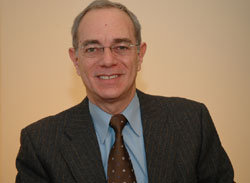| home this issue archives editorial board contact us faculty website |

| Vol.
XVIII No.
1 September / October 2005 |
| contents |
| Printable Version |
So, Just What Does an MIT Provost Do?
Many of you (including a dean or two!) have recently asked me: "So, what does an MIT provost do?" And, "What does the word 'provost' mean, anyway?" Taking the second question first, the Encarta Dictionary defines a provost as: a. "the keeper of a prison," b. "the senior dignitary of a cathedral or collegiate church," and c. "a high-ranking administrative officer of a university." By process of elimination, let's settle on c.
Now regarding the first question, the short answer is that the provost works with the president, the chancellor, and the academic deans to set the academic goals and priorities of the Institute, and with the executive vice president to coordinate the financial planning and budget process, all with an eye to furthering the academic mission of MIT. One of the provost's primary responsibilities is to help define our academic priorities. In doing so, the provost works closely with our deans and, most importantly, the provost listens to and learns from our faculty. It is, in fact, a critical part of the provost's job to understand the goals and aspirations of our faculty and to represent them in the highest decision-making councils of the Institute.
So, you may wonder, what are our academic priorities? It is too early in the administration of President Hockfield to roll out a full set of priorities, but as you know, the President announced two major initiatives in her inaugural address: energy, and the convergence of the life sciences and engineering. These priorities were not created in the President's Office. They were identified by the faculty and embraced by the President as two areas in which MIT should lead.

For many years, MIT has attracted smart individuals from all over who want to study, learn, do research, and interact with some of the smartest people on earth. This should not change. MIT is an electric place (my apologies, I do have an EE background . . .), where excitement and passion for what people do here is palpable everywhere. In my opinion, MIT is the most exciting academic place on the planet. It is a treasure: a symbol of excellence and meritocracy not just for the country but also for the world. But how do we keep MIT at the forefront of education, of knowledge creation, of idea generation? You do it by relying on our faculty: by encouraging and stimulating them to dream of inventing the future, and by recognizing and supporting those dreams.
Beyond the energy initiative, and the convergence of life sciences and engineering, I expect many exciting and important opportunities to emerge from our discussions with faculty throughout the Institute. We will be doing a great deal of listening and learning over the next few months, but there are a few challenges (read "opportunities") that are already clear. First is the challenge of globalization. Today, our graduates compete not only with graduates from other U.S. institutions for jobs in this country, but also with graduates from foreign institutions for jobs in the global market. How should we best prepare our students for this changing landscape?
Second, there are exciting opportunities in innovation, whether in our curriculum and pedagogy, or in teaching our students how to use new fundamental knowledge to create technological innovation. And third, we need to maintain the unique culture of MIT, while making improvements and exercising leadership in areas that the society as a whole needs to address. For instance, building on the principle of meritocracy that is so much a part of the MIT fabric, we must increase the diversity of our faculty, students, and staff. There are other important issues, of course, but let's leave something for future Newsletters .
In short, MIT has been the place to be for many of us, and we want it to stay as the place to be for future generations of students and faculty who want to live and work among the best and brightest. It is part of the provost's job to make sure that our faculty and students are given the opportunities and support needed to invent the future. It is, after all, our faculty and students who make MIT the treasure that it is.
| Back to top | |
| Send your comments |
| home this issue archives editorial board contact us faculty website |